August 2021
August 16, 2021
Melvin Belli Drinks Glenfiddich
The ad below, in which trial lawyer Melvin Belli endorsed Glenfiddich scotch, ran in the New York Times and New York Magazine in early 1970. Taken at face value, it doesn't seem like a particularly noteworthy ad. However, it occupies a curious place in legal history.Before the 1970s, it was illegal for lawyers to advertise their services. So when Belli appeared in this ad, the California State Bar decided he had run afoul of this law — even though he hadn't directly advertised his services. It suspended his license for a year. The California Supreme Court later lowered this to a 30-day suspension — but it didn't dismiss the punishment entirely.
Some high-placed judges felt sympathetic to Belli, which added fuel to the movement to end the 'no advertising' law for lawyers, and by 1977, the Supreme Court had struck down the ban on advertising, saying that it violated the First Amendment. That's why ads for legal services now appear all over the place. Compared to the ads one sees nowadays, Belli's scotch endorsement really seems like no big deal at all.
More info: Belli v. State Bar, "Remember when lawyers couldn't advertise?"
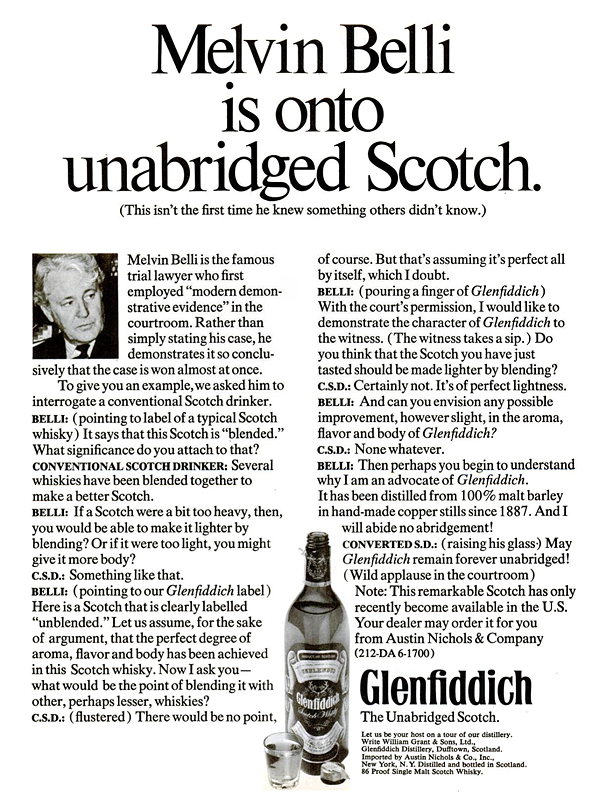
New York Magazine - Mar 2, 1970
Posted By: Alex - Mon Aug 16, 2021 -
Comments (5)
Category: Law, Advertising, 1970s
California Soap Mine
Was the 1855 Soap Mine tale just a prank or hoax? What about the 1901 article, in third place, which sounds a little more scientific?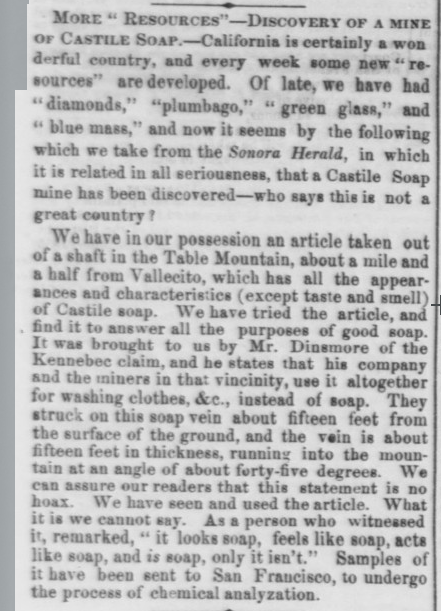
Source.
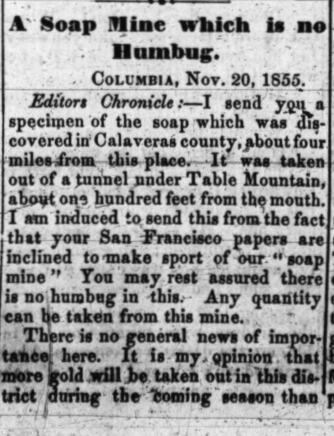
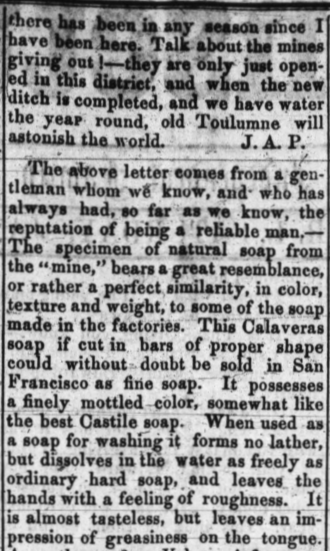
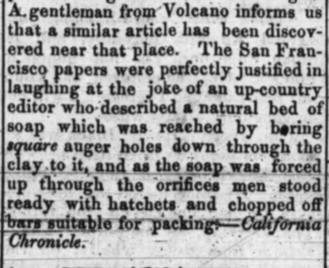
Source.
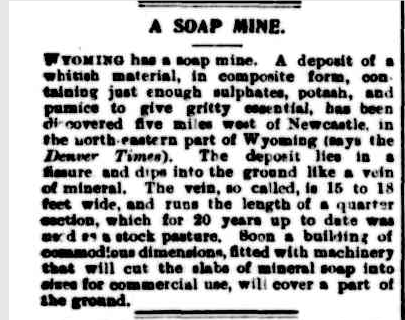
Source.
Posted By: Paul - Mon Aug 16, 2021 -
Comments (3)
Category: Freaks, Oddities, Quirks of Nature, Hoaxes and Imposters and Imitators, Humor, Hygiene, Regionalism, Natural Wonders, Nineteenth Century, Twentieth Century
August 15, 2021
Wrinkle Chaser
Unusual job: A wrinkle chaser uses a hot-air jet to 'chase' wrinkles out of leather boots and shoes. This is done using a wrinkle chaser machine.
Tacoma News Tribune - Jan 6, 1957
Posted By: Alex - Sun Aug 15, 2021 -
Comments (1)
Category: Jobs and Occupations, Shoes
Follies of the Madmen #513

What size of empty container was used to make that ice cylinder for the Pepsi bottle, and what size freezer could accommodate it? Only commercial units. How many hours would you have to prolong your sipping, to justify the creation of that ridiculous amount of ice for cooling one bottle of Pepsi? And was this gal the only one at the bonfire to receive such a treat? So many questions...
Posted By: Paul - Sun Aug 15, 2021 -
Comments (4)
Category: Business, Advertising, Excess, Overkill, Hyperbole and Too Much Is Not Enough, Soda, Pop, Soft Drinks and other Non-Alcoholic Beverages, 1960s
August 14, 2021
Immaculate Heart Trio
The Immaculate Heart Trio consisted of three sisters from the Immaculate Heart order who also happened to be biological sisters.
Miami Herald Sun - Nov 17, 1957
You can listen to one of their albums on YouTube, but only on YouTube because embedding is disabled.

Posted By: Alex - Sat Aug 14, 2021 -
Comments (4)
Category: Family, Music, Nuns
Miss Nude America 1969
Miss nude America: Mrs. Peter Boisclair; 22; poses for photographers at Toronto International Airport on her return home after winning Miss Nude America title at Naked City; Ind.; Saturday. In contest she wore shoes; hard hat.
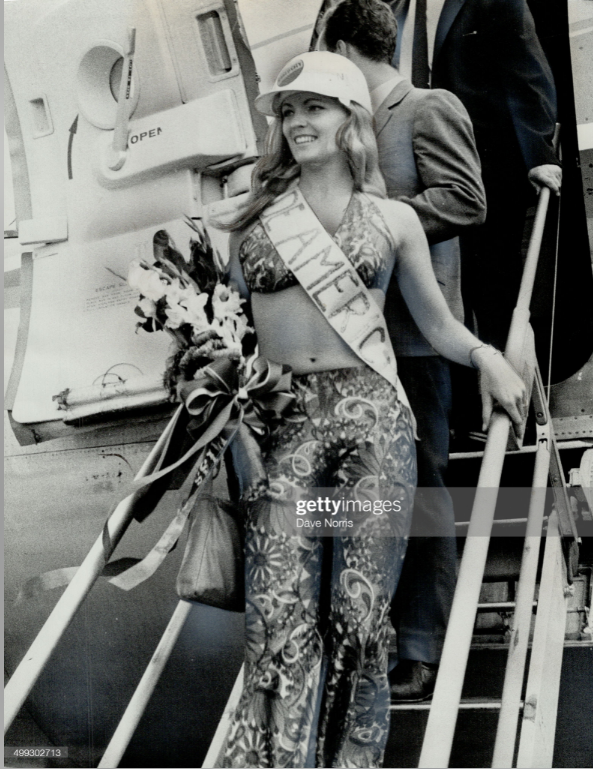
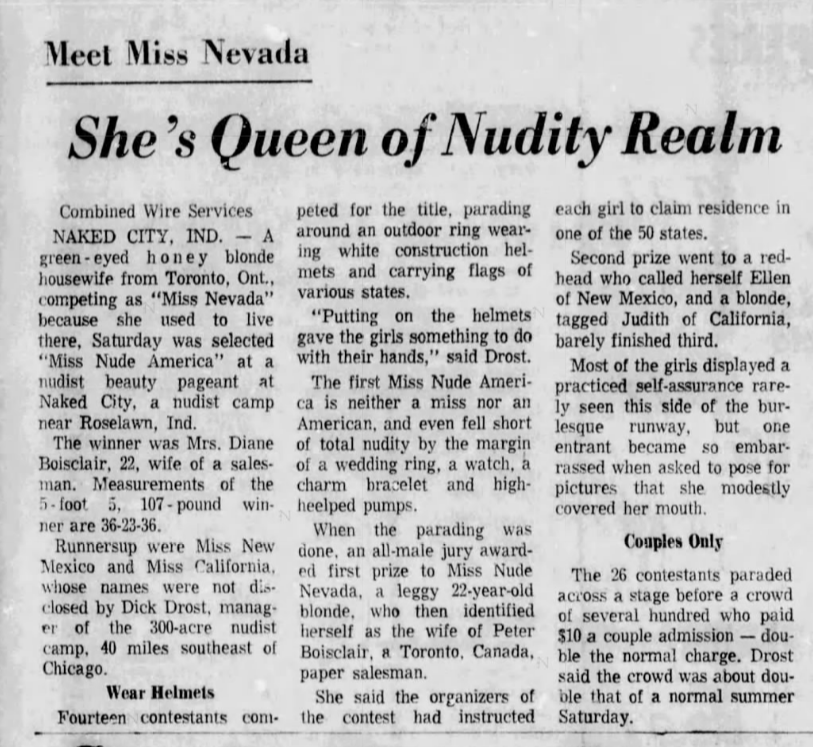
Source: The Salt Lake Tribune (Salt Lake City, Utah)03 Aug 1969, Sun Page 14
Posted By: Paul - Sat Aug 14, 2021 -
Comments (3)
Category: Awards, Prizes, Competitions and Contests, Beauty, Ugliness and Other Aesthetic Issues, Burlesque, Exotic Dancing, Stripping and Other Forms of Staged Nakedness, 1960s
August 13, 2021
Zero Gravity Toilet Instructions
This has been circulating around for a while, but it was new to me so perhaps it'll be new to others as well.In one scene during 2001: A Space Odyssey, the character of Dr. Heywood Floyd uses a "zero gravity toilet" while he's on the space station. He's shown briefly examining the lengthy list of instructions on the wall next to the toilet.
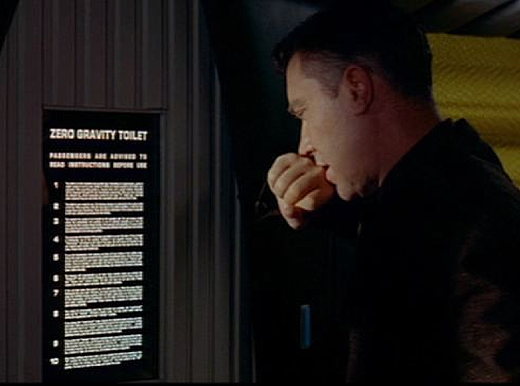
Stanley Kubrick was so obsessive over details that, instead of using gobbledygook, placeholder text for the sign, he actually had someone create a list of toilet instructions. Film buffs have extracted this text, and it's available for purchase as a poster (perhaps to hang in your bathroom) or printed on a t-shirt. (I won't link to any specific retailers, but they're easy enough to find using Google).
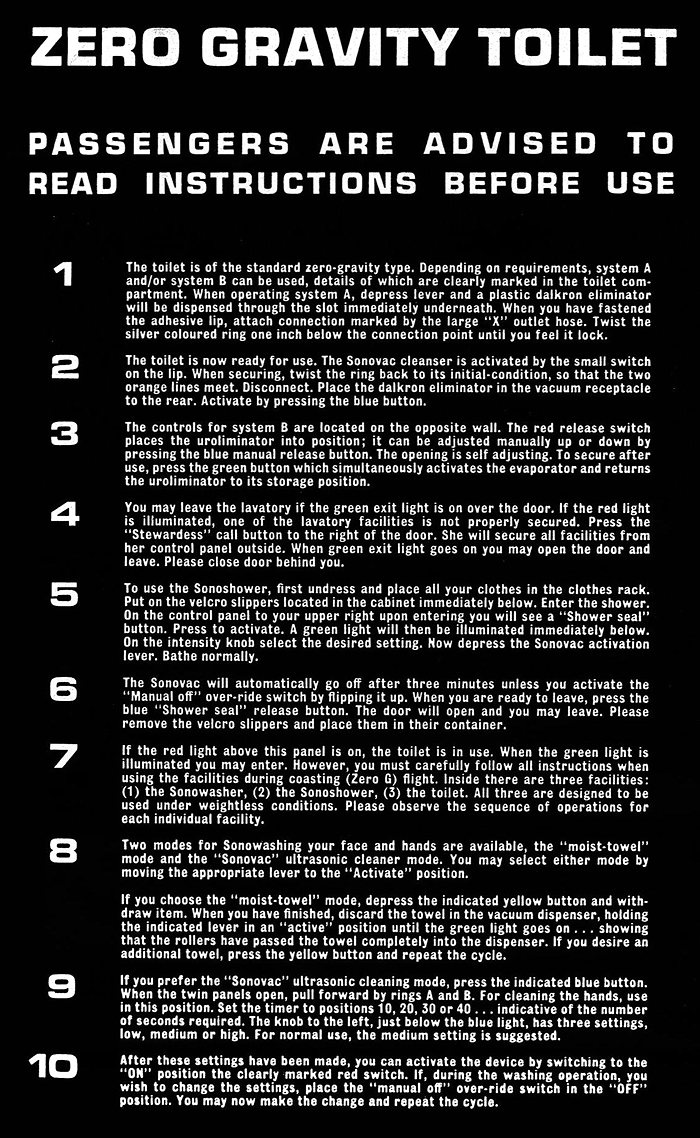
Far Out magazine suggests the zero-gravity toilet instructions may have deeper meaning within the broader context of the film:
Posted By: Alex - Fri Aug 13, 2021 -
Comments (3)
Category: Bathrooms, Movies, Space Travel
1965 Vogue Lingerie Feature
To see larger images of every page, go to link.CAUTION: NSFW pop-ups might intervene!

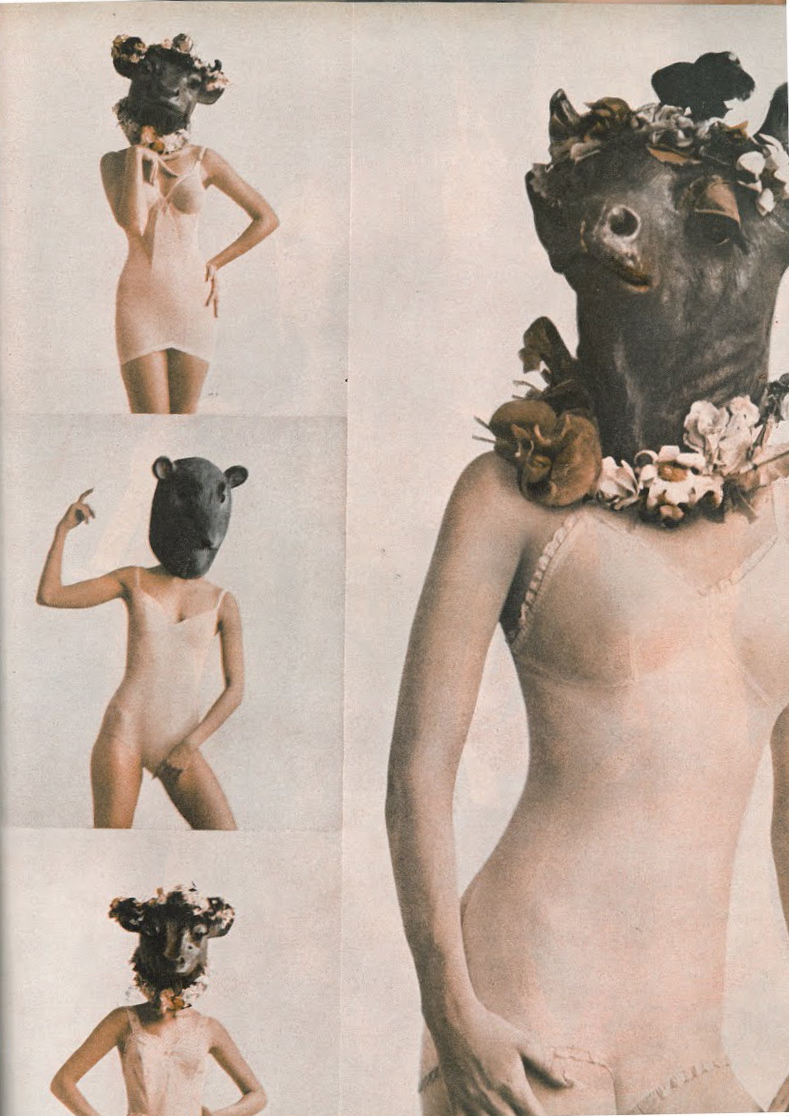
Posted By: Paul - Fri Aug 13, 2021 -
Comments (0)
Category: Animals, Anthropomorphism, Fashion, Underwear, Surrealism, 1960s
August 12, 2021
Soundblast
Soundblast was a 1956 album by the duo Arthur Ferrante and Louis Teicher who met while studying at the Juilliard School of Music. It was marketed as space-age music representative of the kind of music that inhabitants of the "remotest worlds" might listen to.But the real gimmick of the album was that all the sounds on it, including the percussion, was produced by pianos. Details from the Miami News (Nov 17, 1957):
Nor does either of them hesitate to use his elbow, forearms or knuckles to elicit a desired chordal effect—not to mention an assortment of wooden and metal gadgets designed to give the pianos a new personality...
Their goal always is to achieve the maximum tonal contrasts and to simulate orchestral color as vividly as possible within the limitations of pianistic dynamics.
More info: The Soundblast liner notes
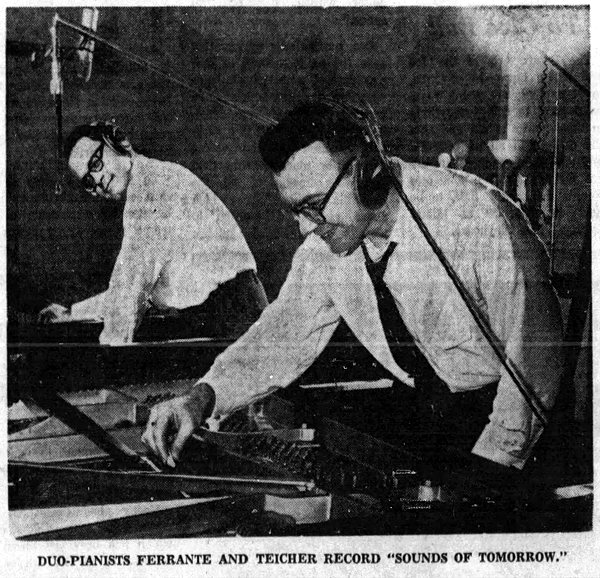
Miami News - Nov 17, 1957
Wikipedia has an interesting biographical detail about Ferrante. Apparently he died in 2009, twelve days after his 88th birthday, thereby fulfilling his ambition to live one year for each piano key.
Posted By: Alex - Thu Aug 12, 2021 -
Comments (1)
Category: Music, Space-age Bachelor Pad & Exotic, 1950s
Link
Stop-motion allied with Rube Goldberg: now that's innovative!Other videos here.
Posted By: Paul - Thu Aug 12, 2021 -
Comments (0)
Category: Anthropomorphism, Rube Goldberg Devices, Stop-motion Animation, Asia
| Get WU Posts by Email | |
|---|---|

| Who We Are |
|---|
| Alex Boese Alex is the creator and curator of the Museum of Hoaxes. He's also the author of various weird, non-fiction books such as Elephants on Acid. Paul Di Filippo Paul has been paid to put weird ideas into fictional form for over thirty years, in his career as a noted science fiction writer. He has recently begun blogging on many curious topics with three fellow writers at The Inferior 4+1. Chuck Shepherd Chuck is the purveyor of News of the Weird, the syndicated column which for decades has set the gold-standard for reporting on oddities and the bizarre. Our banner was drawn by the legendary underground cartoonist Rick Altergott. Contact Us |

